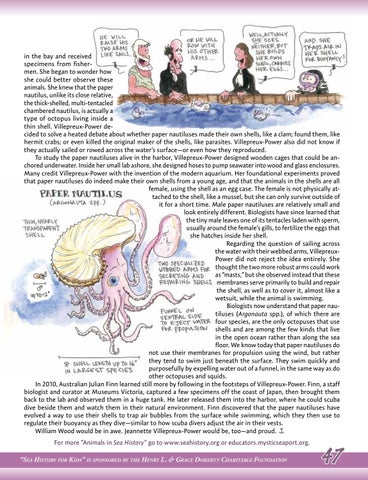in the bay and received specimens from fishermen. She began to wonder how she could better observe these animals. She knew that the paper nautilus, unlike its close relative, the thick-shelled, multi-tentacled chambered nautilus, is actually a type of octopus living inside a thin shell. Villepreux-Power decided to solve a heated debate about whether paper nautiluses made their own shells, like a clam; found them, like hermit crabs; or even killed the original maker of the shells, like parasites. Villepreux-Power also did not know if they actually sailed or rowed across the water’s surface—or even how they reproduced. To study the paper nautiluses alive in the harbor, Villepreux-Power designed wooden cages that could be anchored underwater. Inside her small lab ashore, she designed hoses to pump seawater into wood and glass enclosures. Many credit Villepreux-Power with the invention of the modern aquarium. Her foundational experiments proved that paper nautiluses do indeed make their own shells from a young age, and that the animals in the shells are all female, using the shell as an egg case. The female is not physically attached to the shell, like a mussel, but she can only survive outside of it for a short time. Male paper nautiluses are relatively small and look entirely different. Biologists have since learned that the tiny male leaves one of its tentacles laden with sperm, usually around the female’s gills, to fertilize the eggs that she hatches inside her shell. Regarding the question of sailing across the water with their webbed arms, VillepreuxPower did not reject the idea entirely. She thought the two more robust arms could work as “masts,” but she observed instead that these membranes serve primarily to build and repair the shell, as well as to cover it, almost like a wetsuit, while the animal is swimming. Biologists now understand that paper nautiluses (Argonauta spp.), of which there are four species, are the only octopuses that use shells and are among the few kinds that live in the open ocean rather than along the sea floor. We know today that paper nautiluses do not use their membranes for propulsion using the wind, but rather they tend to swim just beneath the surface. They swim quickly and purposefully by expelling water out of a funnel, in the same way as do other octopuses and squids. In 2010, Australian Julian Finn learned still more by following in the footsteps of Villepreux-Power. Finn, a staff biologist and curator at Museums Victoria, captured a few specimens off the coast of Japan, then brought them back to the lab and observed them in a huge tank. He later released them into the harbor, where he could scuba dive beside them and watch them in their natural environment. Finn discovered that the paper nautiluses have evolved a way to use their shells to trap air bubbles from the surface while swimming, which they then use to regulate their buoyancy as they dive—similar to how scuba divers adjust the air in their vests. William Wood would be in awe. Jeannette Villepreux-Power would be, too—and proud. For more “Animals in Sea History” go to www.seahistory.org or educators.mysticseaport.org.
“Sea History for K ids” is sponsored by the Henry L. & Grace Doherty Charitable Foundation
47
SEA HISTORY 164, AUTUMN 2018 47
